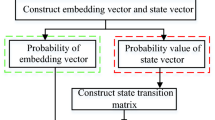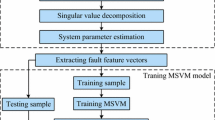Abstract
The gearbox of a wind turbine (WT) has dominant failure rates and highest downtime loss among all WT subsystems. Thus, gearbox health assessment for maintenance cost reduction is of paramount importance. The concurrence of multiple faults in gearbox components is a common phenomenon due to fault induction mechanism. This problem should be considered before planning to replace the components of the WT gearbox. Therefore, the key fault patterns should be reliably identified from noisy observation data for the development of an effective maintenance strategy. However, most of the existing studies focusing on multiple fault diagnosis always suffer from inappropriate division of fault information in order to satisfy various rigorous decomposition principles or statistical assumptions, such as the smooth envelope principle of ensemble empirical mode decomposition and the mutual independence assumption of independent component analysis. Thus, this paper presents a joint subspace learning-based multiple fault detection (JSL-MFD) technique to construct different subspaces adaptively for different fault patterns. Its main advantage is its capability to learn multiple fault subspaces directly from the observation signal itself. It can also sparsely concentrate the feature information into a few dominant subspace coefficients. Furthermore, it can eliminate noise by simply performing coefficient shrinkage operations. Consequently, multiple fault patterns are reliably identified by utilizing the maximum fault information criterion. The superiority of JSL-MFD in multiple fault separation and detection is comprehensively investigated and verified by the analysis of a data set of a 750 kW WT gearbox. Results show that JSL-MFD is superior to a state-of-the-art technique in detecting hidden fault patterns and enhancing detection accuracy.
Similar content being viewed by others
References
IEA Wind. IEA wind annual report for 2015. 2015. Retrieved from https://www.ieawind.org/annual_reports_PDF/2015.html
Global Wind Energy Council. Global statistics. 2015. Retrieved from http://www.gwec.net/global figures/graphs
Chen X, Yan R, Liu Y. Wind turbine condition monitoring and fault diagnosis in China. IEEE Instrumentation & Measurement Magazine, 2016, 19(2): 22–28
Liu W, Tang B, Han J, et al. The structure healthy condition monitoring and fault diagnosis methods in wind turbines: A review. Renewable & Sustainable Energy Reviews, 2015, 44: 466–472
Dinwoodie I, McMillan D, Revie M, et al. Development of a combined operational and strategic decision support model for offshore wind. Energy Procedia, 2013, 35: 157–166
World Wind Energy Association. Wind turbine maintenance & condition monitoring. Retrieved from: http://www.wwindea.org/ technology/ch03/estructura-en.htm.
Sheng S. Gearbox Reliability Collaborative Update. Technical Report PR-5000-60141. 2013
Igba J, Alemzadeh K, Durugbo C, et al. Performance assessment of wind turbine gearboxes using in-service data: Current approaches and future trends. Renewable & Sustainable Energy Reviews, 2015, 50(6): 144–159
Li J, Chen X, Du Z, et al. A new noise-controlled second-order enhanced stochastic resonance method with its application in wind turbine drivetrain fault diagnosis. Renewable Energy, 2013, 60(4): 7–19
Tang B, Song T, Li F, et al. Fault diagnosis for a wind turbine transmission system based on manifold learning and Shannon wavelet support vector machine. Renewable Energy, 2014, 62(3): 1–9
He G, Ding K, Li W, et al. A novel order tracking method for wind turbine planetary gearbox vibration analysis based on discrete spectrum correction technique. Renewable Energy, 2016, 87(Part 1): 364–375
Hu A, Yan X, Xiang L. A new wind turbine fault diagnosis method based on ensemble intrinsic time-scale decomposition and WPTfractal dimension. Renewable Energy, 2015, 83: 767–778
Feng Z, Liang M. Fault diagnosis of wind turbine planetary gearbox under nonstationary conditions via adaptive optimal kernel time frequency analysis. Renewable Energy, 2014, 66(3): 468–477
Teng W, Ding X, Zhang X, et al. Multi-fault detection and failure analysis of wind turbine gearbox using complex wavelet transform. Renewable Energy, 2016, 93: 591–598
Du Z, Chen X, Zhang H, et al. Sparse feature identification based on union of redundant dictionary for wind turbine gearbox fault diagnosis. IEEE Transactions on Industrial Electronics, 2015, 62 (10): 6594–6605
Wang J, Gao R X, Yan R. Integration of EEMD and ICA for wind turbine gearbox diagnosis. Wind Energy (Chichester, England), 2014, 17(5): 757–773
Li Z, Jiang Y, Hu C, et al. Recent progress on decoupling diagnosis of hybrid failures in gear transmission systems using vibration sensor signal: A review. Measurement, 2016, 90: 4–19
Zhang H, Chen X, Du Z, et al. Sparsity-aware tight frame learning for rotary machine fault diagnosis. In: Proceedings of 2016 IEEE International Instrumentation and Measurement Technology Conference. IEEE, 2016, 1–6
Cai J, Ji H, Shen Z, et al. Data-driven tight frame construction and image denoising. Applied and Computational Harmonic Analysis, 2014, 37(1): 89–105
Sheng S, Veers P. Wind turbine drivetrain condition monitoring— An overview. In: Proceedings of the Machinery Failure Prevention Technology (MFPT): The Applied Systems Health Management Conference. Dayton, 2011
Sheng S. Wind Turbine Gearbox Condition Monitoring Round Robin Study Vibration Analysis. Technical Report TP-5000-54530. 2012
Zappalá D, Tavner P J, Crabtree C J, et al. Side-band algorithm for automatic wind turbine gearbox fault detection and diagnosis. IET Renewable Power Generation, 2014, 8(4): 380–389
Errichello R, Muller J. Gearbox Reliability Collaborative Gearbox 1 Failure Analysis Report. Technical Report NREL/SR-5000-53062. 2012
Dragomiretskiy K, Zosso D. Variational mode decomposition. IEEE Transactions on Signal Processing, 2014, 62(3): 531–544
Chen X, Du Z, Li J, et al. Compressed sensing based on dictionary learning for extracting impulse components. Signal Processing, 2014, 96A: 94–109
Zhang H, Chen X, Du Z, et al. Kurtosis based weighted sparse model with convex optimization technique for bearing fault diagnosis. Mechanical Systems and Signal Processing, 2016, 80: 349–376
Zhang H, Chen X, Du Z, et al. Nonlocal sparse model with adaptive structural clustering for feature extraction of aero-engine bearings. Journal of Sound and Vibration, 2016, 368: 223–248
Zhang H, Chen X, Du Z, et al. Sparsity-aware tight frame learning with adaptive subspace recognition for multiple fault diagnosis. Mechanical Systems and Signal Processing, 2017, 94: 499–524
Acknowledgements
This work was supported by the National Natural Science Foundation of China (Grant Nos. 51505364 and 51335006), the National Key Basic Research Program of China (Grant No. 2015CB057400), and the Program for Changjiang Scholars. The authors thank NREL for supporting this work and providing the vibration data used for the validation of the JSL-MFD technique.
Author information
Authors and Affiliations
Corresponding author
Rights and permissions
About this article
Cite this article
Du, Z., Chen, X., Zhang, H. et al. Multiple fault separation and detection by joint subspace learning for the health assessment of wind turbine gearboxes. Front. Mech. Eng. 12, 333–347 (2017). https://doi.org/10.1007/s11465-017-0435-0
Received:
Accepted:
Published:
Issue Date:
DOI: https://doi.org/10.1007/s11465-017-0435-0




